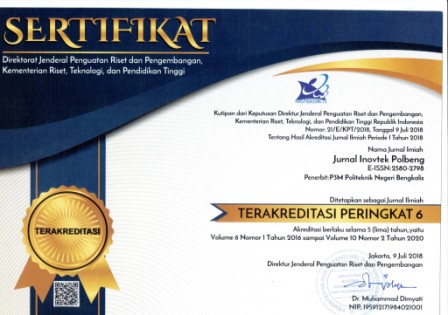Identifikasi Sinyal Elektromiografi Otot Vastus Medialis dan Erector Spinae dalam Transisi Gerakan untuk Kontrol Robot Kaki
Abstract
Keywords
Full Text:
PDFReferences
R. H. Chowdhury et al., “Surface Electromyography Signal Processing and Classification Techniques,†pp. 12431–12466, 2013.
D. A. Jaffray, “World congress on medical physics and biomedical engineering, june 7-12, 2015, Toronto, Canada,†IFMBE Proc., vol. 51, pp. 994–997, 2015.
S. Ferrante, G. Ferrigno, and A. Pedrocchi, “Electromyographic analysis of standing up and sitting down,†no. July, pp. 285–287, 2005.
A. I. Cuesta-Vargas and M. González-Sánchez, “Differences in muscle activation patterns during sit to stand task among subjects with and without intellectual disability,†Biomed Res. Int., vol. 2013, 2013.
N. Ertekin and C. Ertekin, “Erector spinae muscle responses while standing.,†J. Neurol. Neurosurg. Psychiatry, vol. 44, no. 1, pp. 73–8, 1981.
S. M. Taslim Reza, N. Ahmad, I. A. Choudhury, and R. A. Raja Ghazilla, “A fuzzy controller for lower limb exoskeletons during sit-to-stand and stand-to-sit movement using wearable sensors,†Sensors (Switzerland), vol. 14, no. 3, pp. 4342–4363, 2014.
H. (Helen) H. Fan Zhang, “Real-Time Recognition Of User Intent For Neural Control Of Artificial Legs,†2011.
U. Cˆ, C. L. Fall, A. Drouin, A. Campeau-lecours, and K. Glette, “Deep Learning for Electromyographic Hand Gesture Signal Classification by Leveraging Transfer Learning,†pp. 1–13.
K. Veer and T. Sharma, “A novel feature extraction for robust EMG pattern recognition,†J. Med. Eng. Technol., vol. 40, no. 4, pp. 149–154, 2016.
M. Hamedi, S. Salleh, A. Noor, T. Swee, and I. Afizam, “Comparison of Different Time-domain Feature Extraction Methods on Facial Gestures’ EMGs,†Jpier.Org, pp. 1897–1900, 2012.
N. Nazmi et al., “A Review of Classification Techniques of EMG Signals during Isotonic and Isometric Contractions,†pp. 1–28.
D. Tkach, H. Huang, and T. A. Kuiken, “Study of stability of time-domain features for electromyographic pattern recognition,†pp. 1–13, 2010.
O. Triwiyanto, Wahyunggoro and H. A. Nugroho, “Quantitative Relationship Between Feature Extraction of sEMG and Upper Limb Elbow Joint Angle,†2016 Int. Semin. Appl. Technol. Inf. Commun., pp. 44–50, 2016.
W. Mohd, B. Wan, A. B. Yahya, C. S. Horng, and M. F. Sulaima, “Features Extraction of Electromyography Signals in Time Domain on Biceps Brachii Muscle,†vol. 3, no. 6, pp. 3–7, 2013.
G. Alcantara, “Empirical analysis of non-linear activation functions for Deep Neural Networks in classification tasks,†no. 2, 2017.
C. J. De Luca, “Surface ELectromyography : Detection and Recording,†DelSys Inc., vol. 10, no. 2, pp. 1–10, 2002.
B. Hudgins, P. Parker, and R. N. Scott, “A New Strategy for Multifunction Myoelectric Control,†IEEE Trans. Biomed. Eng., vol. 40, no. 1, pp. 82–94, 1993.
T. R. Farrell and R. F. Weir, “The optimal controller delay for myoelectric prostheses,†IEEE Trans. Neural Syst. Rehabil. Eng., vol. 15, no. 1, pp. 111–118, 2007.
B. Peerdeman et al., “Myoelectric forearm prostheses: State of the art from a user-centered perspective,†J. Rehabil. Res. Dev., vol. 48, no. 6, p. 719, 2011.
DOI: https://doi.org/10.35314/ip.v9i2.1011
Refbacks
- There are currently no refbacks.
Copyright (c) 2019 INOVTEK POLBENG
This Journal has been listed and indexed in :

inovtek polbeng by http://ejournal.polbeng.ac.id/index.php/IP is licensed under a Creative Commons Attribution-ShareAlike 4.0 International License









